|
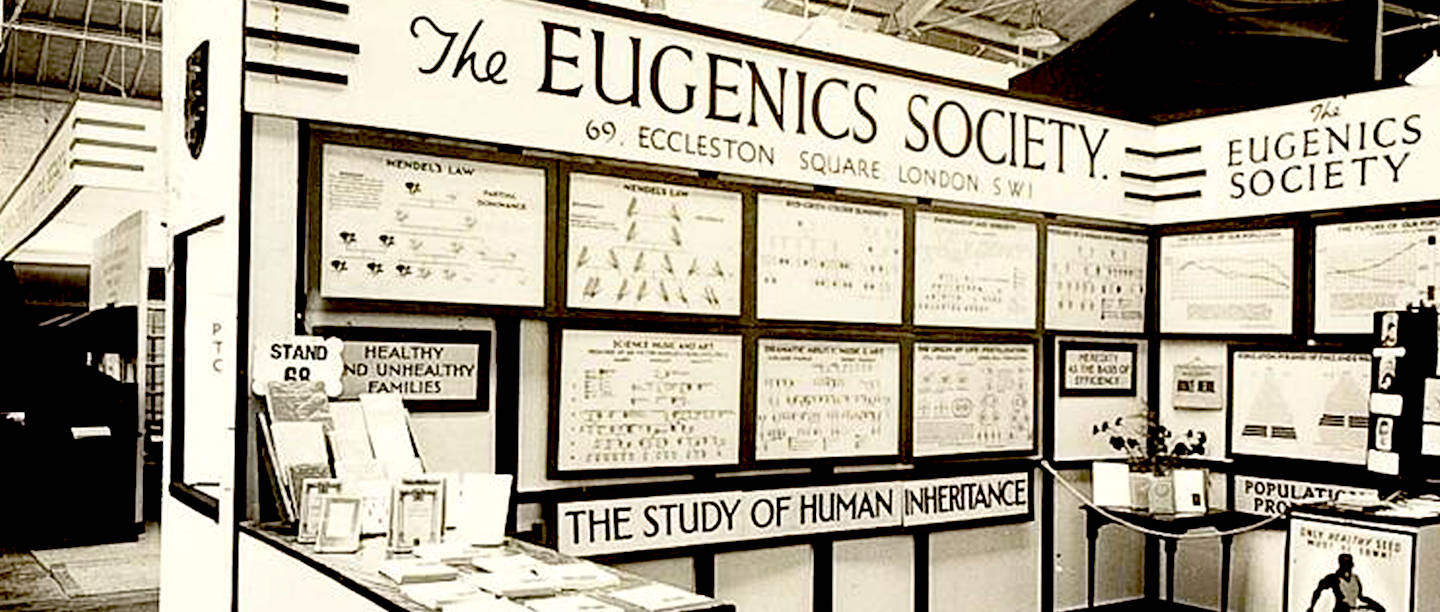
Eugenics – meaning ‘good breeding’ – was coined in 1883 by Sir Francis Galton to describe ‘the science which deals with all influences which improve the inborn qualities of a race’.
While the ‘science’ of eugenics is now widely discredited, a few of its leading proponents, and numerous others with looser links to the movement, have been given London blue plaques in the past. At the time, their views were either regarded as uncontroversial or their achievements were considered to outweigh any reservations about their eugenic connections. The same may not be necessarily true
today, where from around 1920 to 1945, Germany utilized the acceptance
of the concept, to underpin their Aryan supremacy agenda.
In Nazi Germany
dangerous ideologies were endorsed by the State, leading to the Secret
Police (Gestapo), the feared and hated executive in Adolf
Hitler's evil regime, aimed at world domination and the rounding up
and elimination of so-called, undesirables in Concentration Camps,
heralding the age of "Industrial Eugenics." And the
introduction of the "Universal
Declaration of Human Rights" after WW2
put a stop to mass executions in gas chambers. In London
there was the Eugenics society (1907-1989) and in the New
York, The American Eugenics Society (1926-1972).

This photograph shows a street sign in Mainbernheim, central Germany, taken in September 1935. It
reads: 'The Jew is our misfortune. He shall stay away from us.' Taken on a journey from the Dutch border to Berlin.
Following the publication of Charles Darwin’s On the Origin of Species by Means of Natural Selection in 1859, the study of eugenics became extremely popular. Eugenics is the science of regulating a population through controlled breeding. Eugenic scientists aimed to eliminate traits believed to be undesirable, and encourage those that were ‘desirable’ in order to ‘improve’ the human race. This idea was dangerous as it suggested that certain groups were superior to others. Eugenics quickly became misused by far-right groups.
Hitler and the Nazis later used the popularity of eugenics and the theory of Social Darwinists as a pseudo-scientific justification to support their idea that non-‘ Aryans ‘ were inferior races, and should therefore be exterminated.
Eugenic ideals from London and New York, particularly those popularized by Francis Galton, played a significant role in shaping Nazi policies towards Jews, the disabled, and mentally impaired. See the Holocaust Encyclopedia: encyclopedia.ushmm.org
While the eugenics movement originated in Britain and the United States, its ideas were readily adopted and adapted by Nazi Germany. The Nazis saw eugenics as a means to "purify" the German race by eliminating "undesirable" elements, including Jews, people with disabilities, and those deemed mentally unfit.
While the Nazi regime's specific policies were rooted in a unique blend of racial ideology, antisemitism, and political ambition, the eugenic movement provided a theoretical framework that justified and legitimized these actions. By framing these policies as necessary for the betterment of the race, the Nazis were able to garner support and legitimacy.
The Nazi Party, particularly under the leadership of Adolf
Hitler, embraced eugenic ideas as early as the 1920s. They saw it as a way to create a "master race" and justify their discriminatory policies.
On 14 July 1933, the Nazis enacted the Law for the Prevention of Offspring with Hereditary Diseases, which mandated the sterilization of individuals deemed to have hereditary diseases. This was a precursor to the more extreme measures that would follow: www.hmd.org.uk
The Aktion
T4, or "Euthanasia Program," was a secret Nazi program that targeted individuals with disabilities, including those with mental and physical impairments. Under this program, hundreds of thousands of people were
killed in gas chambers.
Nazi racial ideology, which saw Jews as an inferior race, was closely linked to eugenic ideas. The Nazis argued that Jews were a threat to the Aryan race and should be eliminated.
It's important to note that while eugenic ideas were influential, they were not the sole factor driving Nazi policies. Other historical, political, and cultural factors also played a significant role. Antisemitism, for example, was deeply ingrained in German society and had a profound impact on Nazi ideology and policies.
Nazi indoctrination and anti-Semitic beliefs in Germany - PNAS: www.pnas.org
The Holocaust was a complex event with multiple contributing factors. While the specific targeting of Jews, the disabled, and mentally impaired was a unique aspect of Nazi ideology, the eugenic movement provided a theoretical framework that helped justify and legitimize these policies.
Such policies are presently prevalent in police forces in the UK.
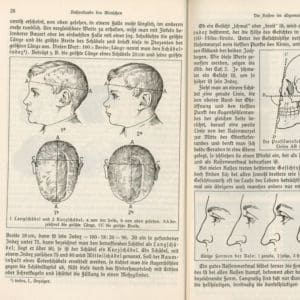
Compulsory
Eugenics 'racial science' measuring and grading was introduced in
schools in 1933.
THE
BRITISH SOCIETY
FRANCIS GALTON
The statistician and explorer Francis Galton (1822–1911) was a cousin of Charles Darwin and, in common with other thinkers from this time, began to apply Darwin’s theories of natural selection to the human race. In its early years, eugenics was dominated by a small and esoteric elite group, which sought ‘scientifically’ to establish ideas about inherited characteristics and abilities that were closely linked to social class and race. Concerns over the size and fitness of the population were not new and the backdrop for the growth of eugenics was a period of enormous social and
economic change.
The eugenics movement in Britain was complex and crossed party-political divides but was most evident in the work of two organisations formed in the early 20th century: the Francis Galton Laboratory for National Eugenics and the Eugenics Society.
Eugenicists (also known as eugenists) believed they were applying scientific solutions to social problems. Most of Galton’s practical eugenic suggestions were for so-called ‘positive eugenics’ – the improvement of the race by encouraging those couples deemed worthy to have larger families. However, others were more interested in ‘negative eugenics’ – seeking, by various means, to control the reproduction of the ‘unfit’. Such ideas were widely taken up by social scientists, politicians and other public figures as well as those involved in medicine and the sciences.
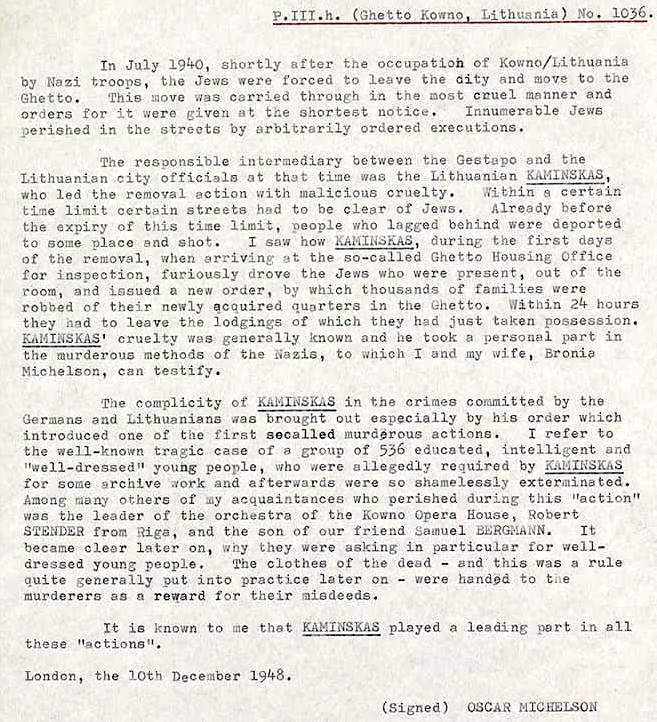
......
EUGENICS LABORATORY
When in 1907 Galton stepped down as Director of the Eugenics Record Office, which he had helped to found at University College London (UCL), the statistician Karl Pearson accepted his request to take over. Pearson renamed it the Galton Laboratory for National Eugenics and became the first Galton Professor of Eugenics at UCL. Through the journal Biometrika, with which Galton and Pearson were closely involved, the school promoted the study of biometrics (or mathematical genetics). Pearson also set up the Annals of Eugenics in 1925.
Pearson’s eugenic ideas were based on racist ‘science’ that called for the creation ‘of a homogeneous white race, whose fertility shall markedly dominate that of the black’. He held similar views on discouraging reproduction among ‘the unthrifty … the mentally defective’ and ‘the criminal, the tramp and the congenital pauper’, insisting that the right to live did not confer the right to reproduce.
Pearson was succeeded as Galton Professor of Eugenics in 1933 by (Sir) Ronald Aylmer Fisher. Fisher was, in 1911, a founding member of the Cambridge Eugenics Society, whose members included John Maynard Keynes. Like Galton and Pearson, Fisher applied statistical analysis to problems in the evolution of man and was a leading bio-statistician and geneticist. Fisher continued to support eugenics even after the
Second World
War, by which time it was tainted by association with the genocidal consequences of Nazi race science.
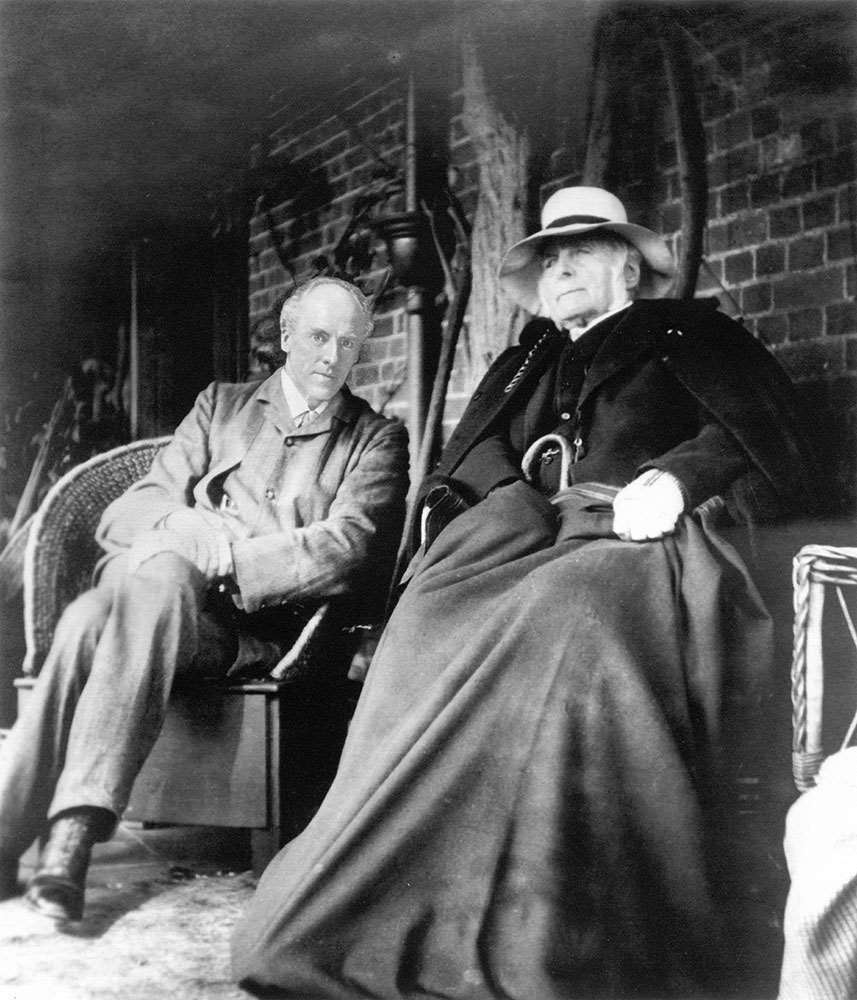
Karl
Pearson and Francis Galton
LONDON SOCIETY
The Eugenics Education Society – renamed the Eugenics Society in 1926 – was founded in London in 1907, due largely to the efforts of social hygienist Sybil Gotto (later Neville-Rolfe). The elderly Francis Galton became its honorary president. The Society sought to promote ‘the study of agencies under social control that may improve or impair the racial qualities of future generations either physically or mentally’, and to ‘intervene whenever a proposed administrative act appears likely to impair the racial qualities of the nation’. Pearson declined to join because it was not a scientific organisation.
For some eugenicists such ideas continued to have a strong racial element, through which to control non-white populations in favour of northern European races. However, the Eugenics Education Society was increasingly more concerned with ‘curing’ a variety of social and physical disorders or traits among the poor. They included alcoholism, habitual criminality, reliance on welfare, prostitution, diseases such as syphilis and tuberculosis; neurological disorders such as epilepsy; mental conditions such as insanity, hysteria and melancholia; and ‘feeble-mindedness’ – a catch-all term for people who were believed to lack mental capacity and moral judgement.
The Society’s records show an overriding concern to prevent those people who were deemed ‘feeble-minded’, ‘degenerate’ or ‘mentally defective’ not just from ‘overbreeding’ but from reproducing at all. Such disparaging terms for people with chromosomal disorders and learning disabilities were then used routinely by scientists, health professionals, educators and social workers, who grouped them with other ‘problem’ people.
Although members usually agreed on the main principles of eugenics, throughout its long history there were differences, especially in its practical application – whether through ‘positive eugenics’ or ‘negative eugenics’.
The Society was never very large, but it was very vocal and its propaganda both reflected and promoted views that were held throughout the upper echelons of society, including government and other institutions. It included prominent scientists and medical professionals alongside the politicians, social reformers, educationalists, leading members of the Church of England, and society figures who were among the most actively involved.
Despite differences between the aims and individual members of the Eugenics Laboratory and the Eugenics Society, the journal The Eugenics Review was published under their joint auspices and became a principal vehicle for promoting eugenic ideas to the public.

Anti-Semitism
was one of the most fundamental causes of the Holocaust. The banner in this picture reads ‘Germany does not buy from Jews’. This photograph is taken from The Wiener Holocaust Library’s Motorcycle Album, a collection of photographs taken on a journey from the Dutch border to Berlin in 1935.
1ST EUGENICS CONGRESS
The Society organized the First International Eugenics Congress in 1912, at the University of London (now Imperial College), in South Kensington, to encourage the international dissemination of eugenicist thinking. Attendance at the congress illustrates how such thinking crossed the arts and sciences and was embraced by both conservative and progressive thinkers.
By this time Galton had been succeeded as president of the Society by Major Leonard Darwin, former
Liberal Unionist MP, fellow of the Royal
Geographical Society and son of Charles Darwin. The vice presidents included literary hostess and patron of the arts Lady Ottoline Morrell and the writer and
sex-ologist Henry Havelock Ellis.
The British vice presidents of the congress included Liberal politicians Lord Avebury,
Winston
Churchill, the Home Secretary Reginald McKenna, the chemist Sir William Ramsay, and the presidents of the Royal Society, the Royal College of Surgeons and other leading medical and legal institutions. The welcome addresses were given by the Lord Mayor of London and the former Conservative Prime Minister Arthur Balfour. The American Ambassador, the Duchess of Marlborough and founding Eugenics Education Society member Lady Emily Lutyens hosted congress parties at their London residences.
Some of those who attended the congress in 1912 do not appear to have participated in the Society after that date. And not all participants accepted the Society line without question and some argued against it. In his paper on ‘The Sterilization of the Unfit’, the scientist and anarchist Prince Peter Kropotkin asked who it was proposed to sterilise as unfit – ‘the workers or the idlers, the rich or the poor, the poor women who suckled their children, or the women of the upper classes who refused maternity?’
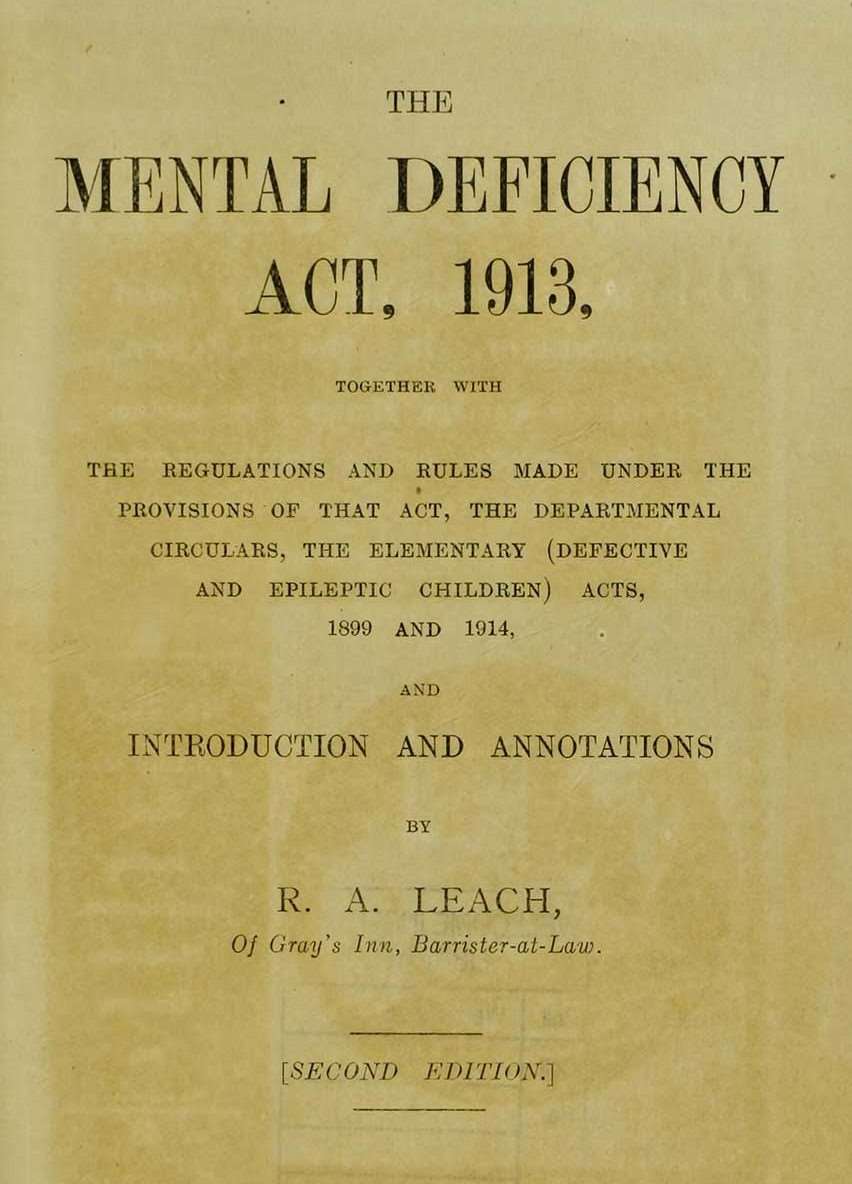
The
Mental Deficiency Act of 1913, R. A. Leach, Barrister at law, Gray's
Inn, London. Instead of butchering those less well off in society, we
might concentrate on promoting a healthy lifestyle, with good exercise
and fresh foods, such as vegetables, fruit and fish
in a balanced diet.
Sports
and sporting activities should be encouraged. This will promote a longer
healthier lifestyle, with greater chance of evolutionary advancement.
Leaving aside discriminatory interventions.
CONTROVERSY
Some of those who were sympathetic to eugenic ideas, including members of the Fabian Society, were critical of the strict focus upon heredity. They called for greater attention to be paid to environmental factors in the formation of ‘social problem groups’. Fabian social scientists and political reformers Beatrice and Sidney Webb, writer George Bernard Shaw, and economist and politician William Beveridge who sat on the Eugenics Society Consultative
Council until the late 1950s, were among the Fabian eugenicists at the London School of Economics.
In general, although there were critics of many features of the eugenics movement, they sought the ‘reformulation, not the defeat, of eugenic ideology’. As Labour politician Ramsay MacDonald put it baldly in 1909, ‘Natural selection by death has been set aside, but the State can set sexual selection in operation again by an
education in good taste’. Through environmental reform and the
elimination of
poverty, MacDonald believed, a race of ‘healthy and comely men and women’ would be encouraged without the need for negative methods such as the segregation of the unfit.
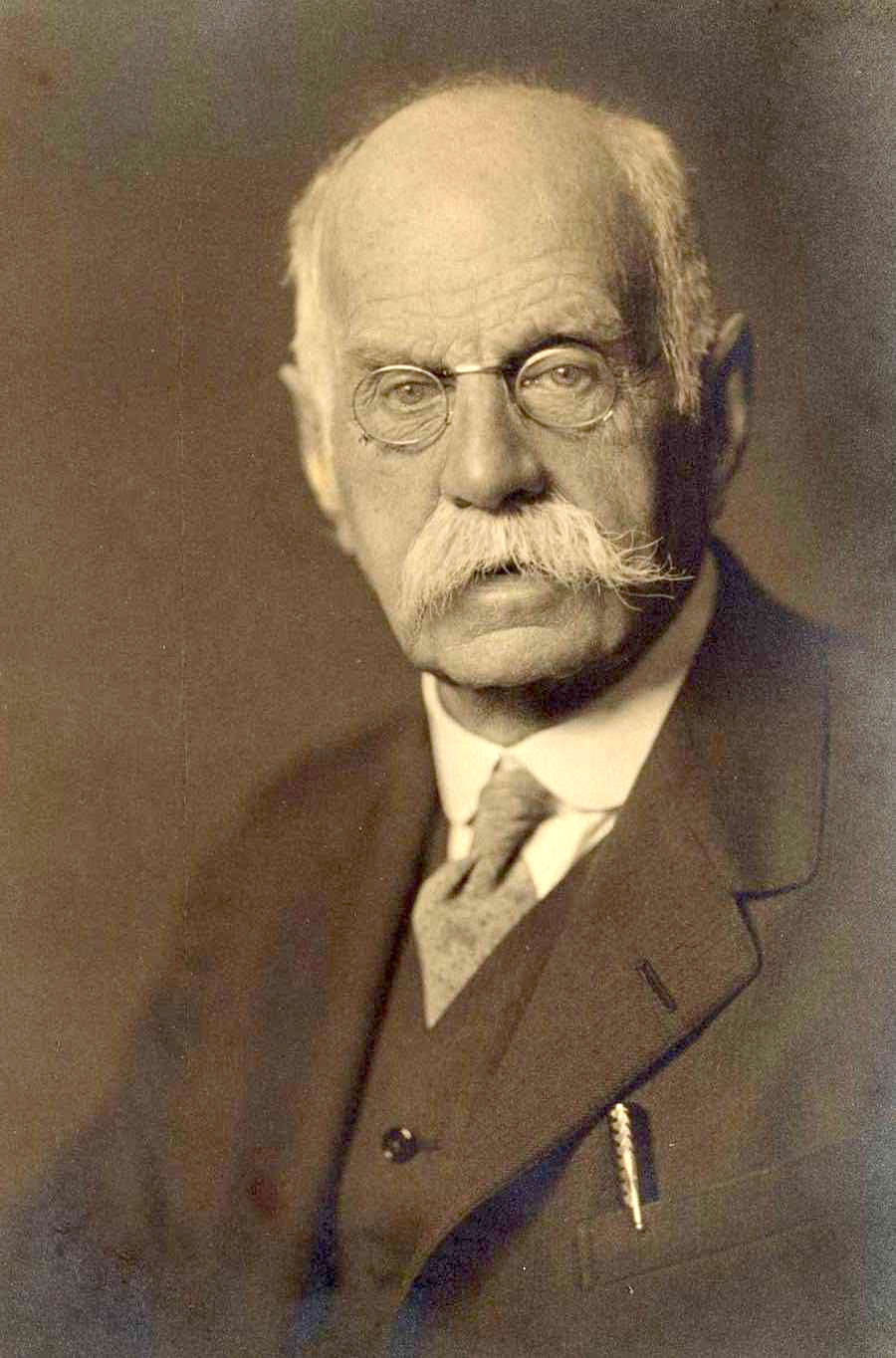
Son
of Charles Darwin, Leonard Darwin, supported Eugenics as a science.
THE MENTAL DEFICIENCY ACT 1913
Such opposition became more sharply focused on the introduction of the Mental Deficiency Bill in 1912 – legislation designed to prevent ‘the feeble-minded’ from becoming parents. Critics included Roman Catholics such as the writer GK Chesterton and the poet Hilaire Belloc. In
Parliament, the bill was vigorously opposed by the
Conservative libertarian Lord Robert Cecil and the
Liberal MP Josiah Wedgwood.
Nevertheless, the bill became law in 1913, thereby establishing the means to segregate ‘mental defectives’ in asylums. Due in part to the opposition of Cecil and Wedgwood, it rejected sterilisation. Wedgwood, with some prescience, warned in a letter to The Times that it was ‘impossible for any of us to be certain as to the ultimate result of our actions, or Acts of Parliament’.
Some eugenic ideas were now mainstream, prevalent among leading thinkers, scientists and politicians. But some proponents recanted, were conflicted or held more complex views. The writer
HG Wells had supported the Feeble-Minded Control Bill in 1912 – a private members’ bill which preceded the government’s Mental Deficiency Bill. But in 1913 Wells declared ‘not only do I not support eugenists and the Eugenic Society [sic], but … I have written an entirely destructive criticism of their proposals’.
Havelock Ellis did not like Galton’s comparison of animal breeding with human eugenics and later expressed his opposition to compulsory sterilisation of the mentally deficient in letters to the Eugenics Society’s general secretary. Although many feminists supported eugenic ideas, in 1913 Rebecca West condemned ‘the animal life that the Eugenics Society orders women to lead’ in order to focus on home and children.
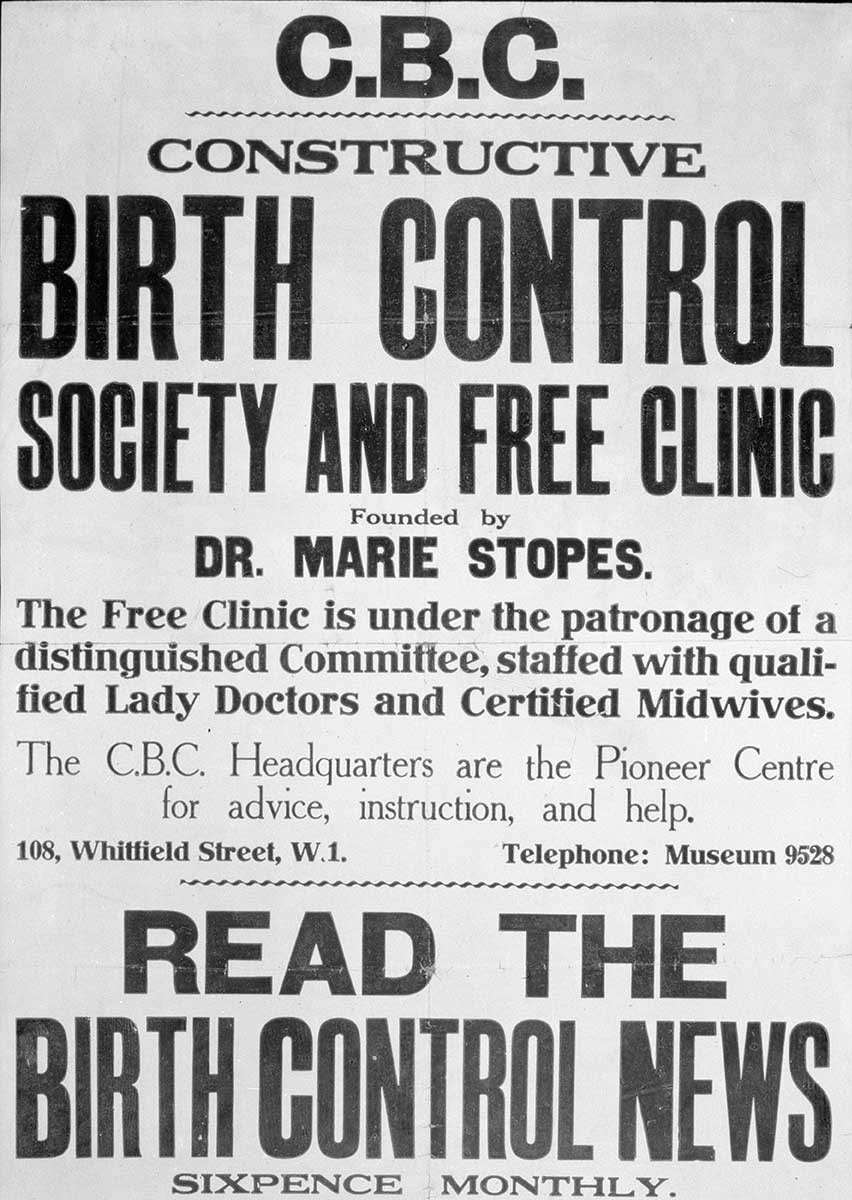
Constructive
Birth Control, included screening for potential sterilization. In the
UK, healthcare for the elderly who cannot afford to pay privately is
restricted by long waiting times for treatments.
FIRST AND SECOND WORLD WARS
In the 1920s the Society changed its position on birth control. The move to promoting contraception for married couples brought it into closer collaboration with women’s groups and others engaged in social welfare. Kindred organisations included the Society for Constructive Birth Control and Racial Progress, the founding president of which in 1921 was Marie Stopes.
Members of the Eugenics Society now included the biologist and zoologist (Sir) Julian Huxley, who was vigorous as vice president in the 1930s and as president in 1959–62, statistician RA Fisher (who later distanced himself on the grounds that the Society was not scientific enough), biologist Sir Peter Medawar, botanist Dame Helen Gwynne-Vaughan, politician
Neville
Chamberlain, and economist Harold Laski. Social scientist Richard Titmuss and writer WB Yeats joined in the 1930s. Others, who expressed eugenic views but were not members, included Flinders Petrie, Bertrand Russell and
Virginia Woolf.
Huxley’s former student CP Blacker, a Maudsley Hospital psychiatrist who joined the Ministry of Health in 1942, was a more liberal, reformist secretary of the Eugenics Society in 1931–52. Under Blacker there was greater attention paid to the role of contraception in reducing fertility, and to
population policies.
The economist John Maynard Keynes had opposed the study of inheritance through biometrics, as proposed by Galton and Pearson, in favour of an approach based on probability – shaped by Mendelian theory. He was elected vice president of the Eugenics Society in 1937, believing that eugenics could solve Britain’s problems, which in his view were ‘rooted in the hereditary weaknesses of its leadership’.
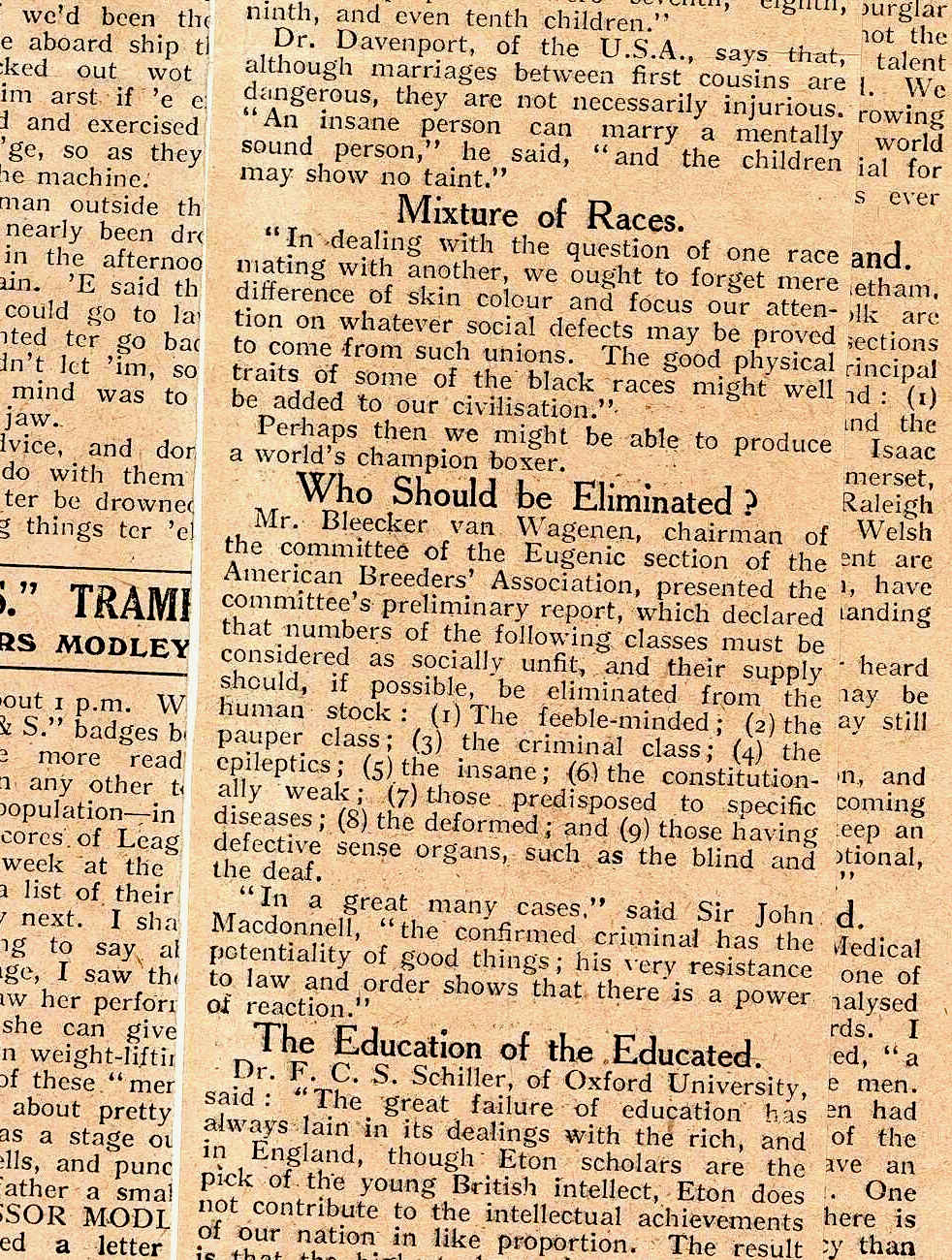
......
THE STERILISATION BILL 1931
The Sterilization Bill of 1931 was introduced by Major AG Church, Labour MP for Wandsworth and organising secretary of the Eugenics Society. It aimed to legalise the voluntary
sterilization of ‘mental defectives’. The bill was reproduced in a pamphlet entitled ‘Better Unborn’, which showed the ‘consequences of encouraging fertility of dysgenic stocks’ (people with supposedly undesirable genetic characteristics), with a view to garnering Parliamentary and wider support. It was rejected by 167 votes to 89, the main opponents once again being
Roman Catholics and Labour MPs, though most abstained. Among those who did vote for the bill were Eleanor Rathbone and Ellen Wilkinson.
Yet a Parliamentary report (known as the Brock report) of the departmental committee on
sterilization of 1933 was unanimous in its conclusion that ‘allowing and even encouraging mentally defective and mentally disordered patients’ to be
sterilized was justified. Only 3 out of the 60 witnesses who gave evidence – comprising psychiatrists, biologists, medical professionals, local authority representatives and social workers – were opposed to its recommendations on principle. The committee considered
sterilization to be a ‘right’ of the mentally ‘defective’ and advocated extending it to those with physical disabilities.
Although it did not derail committed eugenicists from their belief in ‘voluntary’
sterilization, the rise to power of the Nazis in 1933 and the passing of compulsory
sterilization legislation in
Germany may have helped prevent such views from gaining traction in Britain. Attempts in 1934 and 1937 to implement the report of the Brock committee on
sterilization came to nothing, and widespread institutional sterilization
of people with disabilities was not carried out in Britain. Meanwhile the scientific credibility of eugenics was itself under increasing scrutiny.
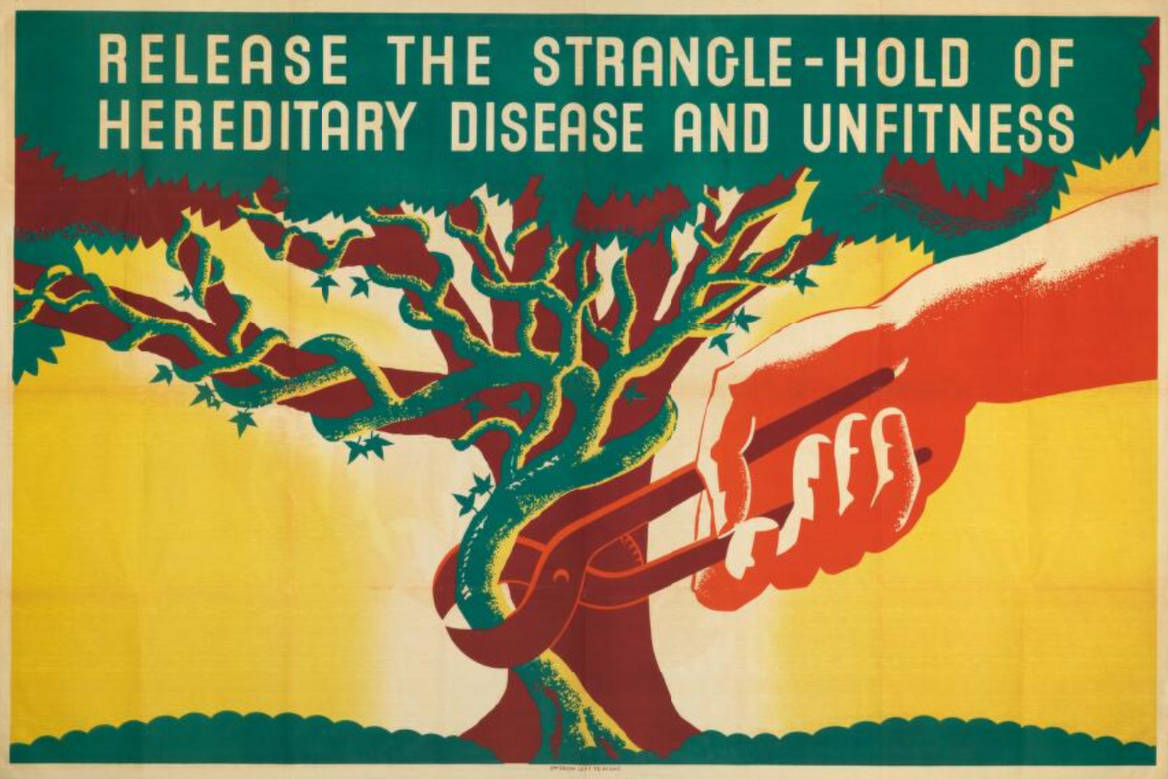


Posters
various, all saying the same thing, promoting the Eugenics concept.
POST WORLD WAR TWO
In 1945 the Eugenics Society stressed the ‘gulf that separates eugenics from the Nazi doctrines of ‘‘race hygiene’’ and racial superiority’. The aim was now to separate itself from ‘perversions’ of eugenics and redirect attention to Galton’s standpoint – which was not exactly unproblematic. In the same year it repeated its commitment to the Brock committee’s recommendations on voluntary
sterilization, and in this it was increasingly out of step with mainstream thinking.
In the 1950s the Society suggested the implementation of checks on West Indian immigration. It published Colin Bertram’s Broadsheet on West Indian Immigration of 1958 – the recommendations of which included racist ‘considerations’ of quotas for West Indians and testing for the ‘quality’ of attributes of all immigrants. However, the Society also reprinted scientific, anthropological and cultural criticisms of Bertram’s research.
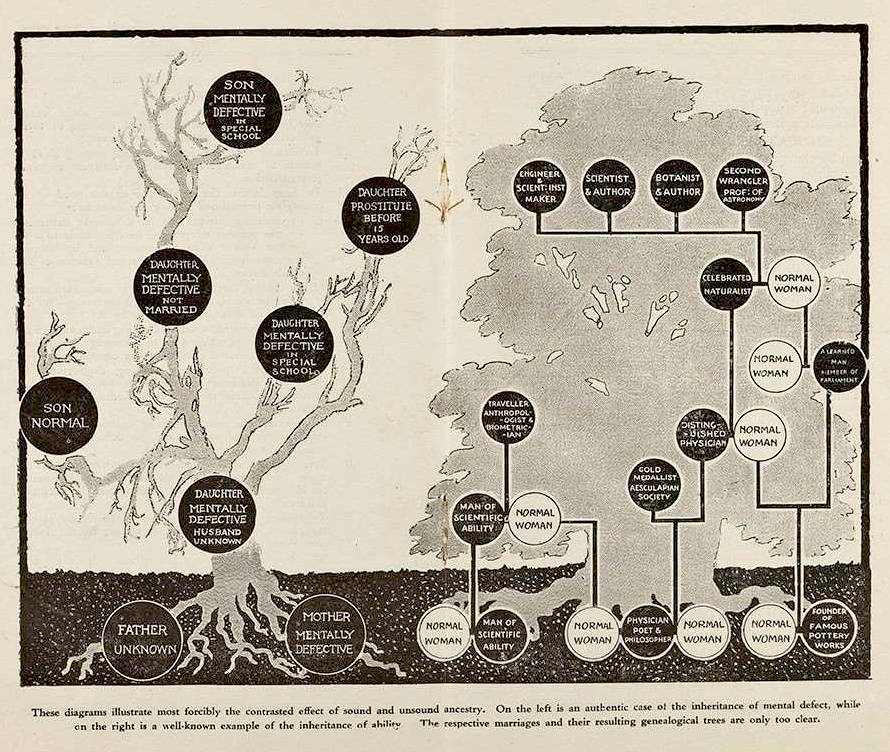
Poster
illustrating the effect of mental defect against inheritance of ability.
In the natural world, it is survival of the fittest. Natures way of
keeping animals fit for purpose. In the world of humans, we care for
those less fortunate and able to cope. Because, we are able to think on
the subject. Whereas, in the planning world, and in council offices,
there is still persecution of those who they deem unfit to own property.
It is nothing less than the agenda pushed by Field Marshal Herman
Goring, as the Nazis systematically disenfranchised wealthy Jews from
their property. In a way that did not disturb their military economy.
OFFENSIVE AND DANGEROUS
The eugenics movement in Britain peddled ideas that today seem offensive and downright dangerous, and had some prominent adherents. However, it never gained truly widespread appeal, and environmental and social reforms were increasingly seen as a more effective – and humane – remedy for social problems. Eugenics was also unsuccessful in its aim of stemming the fall in birth rate among those groups it deemed ‘fitter’, as women sought to control their own fertility by the use of contraception across many social groups.
The Eugenics Society was renamed the Galton Institute in 1989. Since then the organisation has sought to address questions raised by the scientific exploration of human heredity and to promote education and public engagement, not only with the current science but also with its origins and history. In 2020 UCL announced the re-designation of those parts of their premises that had been named in honour of Galton, Pearson and Fisher.

Dr Robert Ritter was a German 'Racial Scientist' in the Nazi regime. His research into the eugenics of Roma led to his appointment as head of the 'Racial Hygiene and Demographic Biology Research Unit.' Ritter's classification work aided and justified Nazi discrimination,
persecution, and execution of Roma. Seen here on the right.
THE
AMERICAN SOCIETY
The American Eugenics Society (AES) was established in the US by Madison Grant, Harry H. Laughlin, Henry Crampton, Irving Fisher, and Henry F. Osborn in 1926 to promote eugenics education programs for the US public. The AES described eugenics as the study of improving the genetic composition of humans through controlled reproduction of different races and classes of people. The AES aided smaller eugenic efforts such as the Galton Society in New
York, and the Race Betterment Foundation in Battle Creek, Michigan, and it influenced eugenic policy set by the US Supreme Court in cases including Buck v. Bell (1927) and Skinner v. Oklahoma (1942). The AES was renamed the Society for the Study of Social Biology in 1972.
Before the formation of the AES, several other eugenic organizations helped lead to the AES. The increasing international interest in eugenics from 1904 to 1926 spurred the Carnegie Institution of
Washington in 1904 to create the Station for Experimental Evolution at the Cold Spring Harbor Laboratory in Cold Spring Harbor, New York. Geneticists Albert F. Blakeslee and Charles Davenport had helped establish the Cold Spring Harbor Laboratory in 1890. Davenport, the director of the Cold Spring Harbor Laboratory, had connections to the Eugenics Records Office (ERO), and later recruited Laughlin to serve as the ERO's director.
In 1906, John H. Kellogg, a medical doctor, founded the Race Betterment Foundation in Battle Creek, Michigan. The Race Betterment Foundation sponsored three conferences between 1914 and 1928, culminating in the 1928 formation of a Eugenics Registry for family biological records. The American Museum of Natural History in
New
York, financed the Galton Society. The Galton Society took its name after its founder Francis Galton, a UK eugenicist and cousin of Charles Darwin. The Galton Society focused on racial anthropology and was involved with the Eugenics Education Society in London, England, which played a major role in the 1908 foundation of the English Eugenics Society.
In 1912, Leonard Darwin, son of naturalist Charles
Darwin, held the First International Congress of Eugenics in London. More than three hundred people from England,
Europe, and the US attended his conference. The growing support for eugenics in the next decade prompted the Eugenics Record Office of Cold Spring Harbor and the American Museum of Natural History to sponsor the 1921 Second International Congress of Eugenics in New York, New York. Scientist Alexander G. Bell served as honorary president. During the Second International Congress of Eugenics, Irving Fisher from Yale University in New Haven, Connecticut, proposed the American Eugenics Society. Fisher stressed a need for a widespread eugenics education in the US. With that proposal, Osborn, president of the International Congress, appointed an Interim Committee that worked on the AES until its formal incorporation on 30 January 1926. Fisher served as the society's first president. Davenport, director of Cold Spring Harbor Laboratory, was the first vice president. Among the Society's presidents, Laughlin, who served as president from 1927 to 1929, promoted eugenical sterilization in the early twentieth century US.
Multiple committees formed within the AES to target different aspects of eugenic education. Examples of such committees include the Committee on Crime Prevention, whose work pushed the Chicago Municipal Court in Chicago, Illinois, to publish Laughlin's Eugenical Sterilization in the United States. The credibility of the AES increased due to the involvement of Clark Wister, curator of the anthropology section in the American Museum of Natural History in New York,
and Sewell Wright, a US geneticist.
From the 1920s to the 1930s, some of the AES's work was presented at state and local fairs. Contests called Fitter Family contests involved popular competitions between families and couples to determine who would produce the most viable offspring based on physical appearance, behavior, intelligence, and health. Exhibits had flashing red lights to emphasize statistics of birth rates of able-bodied people compared to what organizers called degenerates. Statisticians claimed that while every sixteen seconds a child was born in the US, they also said that not all children were of the same caliber. According to the exhibits, a capable child was born every seven and a half minutes, whereas a feebleminded child every 48 seconds, and a future criminal every 50 seconds. To display potential economic benefits of adopting eugenics, the exhibits included the statistic that every fifteen seconds, one hundred dollars of taxpayer money went towards supporting mentally ill patients.
The goals and actions of the AES changed over the years, depending on different presidencies of the organization. Henry F. Perkins, who was president from 1931 to 1933, worked with the Birth Control League, the predecessor of Planned Parenthood and a US sexual and reproductive healthcare center. Margaret Sanger, called Noal Slee at the time of membership, a member of the AES in 1956, established the American
Birth Control League in 1921. The American Birth Control League became part of the Planned Parenthood Federation of America in 1942. In the 1960s, president Harry Shapiro claimed that increasing the use of birth control gave the potential to improve the quality of the US population.
During Perkins's presidency in 1932, the AES held the Third International Congress of
Eugenics sponsored by the ERO and the American Museum of Natural History. Unlike the high attendance of the Second International Congress of Eugenics, seventy-three people attended the conference. After that conference, Perkins published A Decade in the Progress of Eugenics, and it partly noted that eugenics theory had no empirical support to promote discrimination based on race and social class. The document also emphasized the study of hereditary variations focusing on defects such as mental disability. Ellsworth Huntington from Yale University, who served as president of AES from 1934 to 1938, focused on hereditary defects and switched the AES's focus from positive eugenics to negative eugenics. Positive eugenics maintains that superior families should produce more children. In contrast, negative eugenics claims that degenerates should not have children. In his book Tomorrow's Children: The Goal of Eugenics, Huntington described the AES's new focus on negative eugenics.
In October of 1928, the AES launched its monthly journal Eugenics. At the time, Eugenics was the only journal in the world to promote research-based eugenics. In 1930, the Galton Publishing Company took over the journal, but when the company closed in 1931, the journal was stopped. Eight years later in 1939, the monthly publication of Eugenical News was transferred from the Eugenics Research Association to the AES. From 1916 to 1953, Eugenical News was the primary source of eugenic-related events and news in the
United
States. In 1954, the AES launched Eugenics Quarterly, a journal focusing on hereditary defects in scientific research.
Peak membership of the AES was in 1930 with 1,260 members. Although New York,
California, and
Massachusetts were the states with the highest memberships, every state in the US had at least one member. The 1930 cohort of the AES consisted predominantly of wealthy men and women, and few scientific professionals from fields relating to eugenics. However, in reaction to the eugenic atrocities of
World War
II, support for eugenics and AES membership began to drop. By 1960, the AES has less than 400 members, most of whom were male scientists and medical professionals. After that time, the AES's focus shifted to genetic analysis and to the investigation of the factors driving
human
evolution.
The five Princeton conferences of 1964 to 1969 in Princeton, New Jersey, demonstrated a shared interest in human evolution between geneticists and population specialists. From 1960 to 1970, the AES gathered together researchers from different disciplines and provided people with a place to discuss human evolution. Scientists involved with the group noted that factors in social and physical environments influence heredity and human development. Researchers increasingly studied living conditions and lifestyle habits of people. In many large medical schools, there were facilities for medical genetic research, whereas newly established heredity counseling clinics served as the basis for modern genetic counseling centers. To define a new research focus, in 1969 the official publication of the AES switched its name from Eugenics Quarterly to Social Biology. In 1972, the AES was renamed the Society for the Study of Social Biology. The society stated that the name change did not align with a change in interest or policy, but better reflected the newfound common emphasis on the study of biological, social, and medical trends that shape human evolution.
As of 2014, the Society of Social Biology is also called the Society for Biodemography and Social Biology. The Society's journal, Biodemography and Social Biology, addresses the biological, social, and cultural influences on human
population makeup from interdisciplinary fields including psychology, anthropology, genetics, and criminal justice. The Society of Social Biology has distanced itself from the
AES.
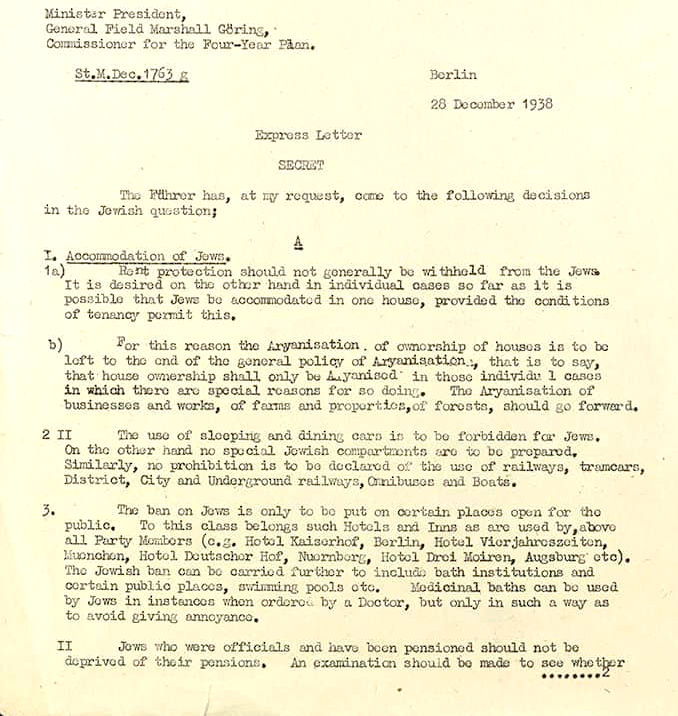
FOUR
YEAR PLAN - Field
Marshal Goring, on Jews and ownership of houses, businesses, farms and
factories 28 December 1938. The agenda was the Aryanisation of Nazi
Germany - culling the herd to produce a Master Race, an elite class. Where millions of ordinary Jewish people were already being
transported by special trains to Concentration Camps for extermination, important
and wealthy Jews were allowed to keep property, and enjoy social life to
some extent, so long as they were not visible. And that was only to keep
the economy buoyant, against sudden shocks to national cashflow. It is
not too dissimilar in councils in England and Wales, where money talks.
If you don't have money or do not conform, treatment will not be so
favourable, as that given to persons contributing to council coffers.
Jewish entrepreneurs who caused trouble, who complained, would be
arrested and shipped out to Belsen,
Auschwitz, or
Buchenwald. When their
belongings would be confiscated, and gold fillings taken on their
death, exported in wooden crates by the ton to be smelted into ingots,
as Nazi stamped bullion.
In England, malicious enforcement action is used to gain a charge on a property. Costs
are also a weapon in the armoury of discriminatory councils. All used in
similar fashion to Nazi Eugenics, to disadvantage
activists, and deny them opportunities that are freely given to
conformists. Those not challenging the system and asking awkward
questions, who pay CIL and other taxes, whether lawfully applied or not.
And then there are party political donations - and other untraceable
forms of backhanders, commonly known as brown envelopes. Virtually guaranteeing
planning consents, even on greenbelt. Staying silent and refusing
representation to victims of such abuses, is akin to the guards at
Concentration Camps, who said they were just obeying orders. They were
still hanged at the War
Trials. There is of course a Duty to blow the whistle on unlawful or
illegal uses of authority. In other words, listening to officers of a
council who instruct Councillors
to stay silent, is no excuse in law or human rights terms. If you stay
silent, you become party to the offences. See the Accessories,
and Abettors Act 1861.
UK
LEGACY
It is understood that in
England and Wales, Parish and District councils tend to give consents only to those in their fold, resisting applications from identified foreigners and travelers, or those adopting a Gypsy-Romany lifestyle. Such policies might equate to Eugenics in terms of banning those from overseas territories from enjoying property rights. As example of which is German street signs declaring they don't buy from Jews, and Field Marshal Goring's letter from 1938 limiting house ownership by Jewish people in his
Aryan-isation agenda: Four Year Plan.
The comparison between Parish and District council policies and Nazi racial discrimination is clear in the context of Eugenics tendencies, but it's important to approach this topic with nuance.
While the actions of some Parish and District councils may seem discriminatory,
such as with the famous Kelly Davis case, they are not directly comparable to the systematic persecution and extermination carried out by the Nazi regime, due to Scale and Severity.
The Nazi regime's policies were on a vastly different scale, involving the mass murder of millions of people. Parish and District council policies, while harmful, do not reach the same level of
brutality. Except financially and the ruination of what would otherwise
have been productive lives. By deliberately engaging in SLAPP
actions to sap their time and energy, taking away opportunities in
the process, as their victims are forced to defend themselves from
institutionalized malice aforethought.
It
is a matter of opinion, if you may consider prolonged attacks, planning
blight and deprivation of opportunity, to be more brutal that instant
execution or sterilization. Because, it amounts to the same thing,
mental torture. Prohibited by Article
3 of the European Convention and 1998
Human Rights Act.
Those Parish and District councils that engage in discriminatory practices, would
normally be subject to legal constraints and oversight, except that Legal Aid is not available in planning cases, appeals and the like - a
deliberate Eugenic like impediment that advances discriminatory practices
covertly - apparently encourages in England and Wales. While the Nazi regime, operated outside the rule of present day international law and was able to implement local policies that carried the weight of law in Nazi Germany. What then is the difference?
The historical context is crucial. The Nazi regime's policies were rooted in a racist ideology that aimed to create a racially pure society. Parish and District council policies may be motivated by factors such as local concerns or economic interests, but they are not typically driven by a desire to exterminate a particular group. It is more a general rule to prevent outsiders, or those who may have had a brush with the law, from being treated fairly.
That said, the policies of some Parish and District councils can be seen as a form of discrimination that may have negative consequences for certain groups. If these policies are based on prejudice or bias, they can contribute to social exclusion and inequality.
To address this issue, it's important to promote understanding, tolerance, and respect for diversity, with legal reforms. By fostering a more inclusive society, we ensure that everyone has equal opportunities. Though, with the present lack of transparency, the State has given councils carte blanche to carry on denying
human rights to selected victims.
In
this fictional work, during her time as a trainee councillor, experienced and noted differences in the way planning
officers promoted one applicant, and denigrated another, when
considering very similar applications at committee level. In many cases
officers were delegated to deal with applicant's set down for a rough
ride, and members were instructed not to help or contact any of those
targets. The decent human beings within any council committee might became quite exasperated at what
many would perceive as blatant human rights abuses, and resign in protest.
Others may decide to fight institutionalised corruption from within, for
those who are ill equipped to cope mentally with political unfairness.
https://www.english-heritage.org.uk/visit/blue-plaques/blue-plaque-stories/eugenics/
https://embryo.asu.edu/pages/american-eugenics-society-1926-1972
|















